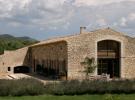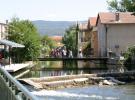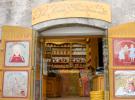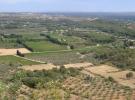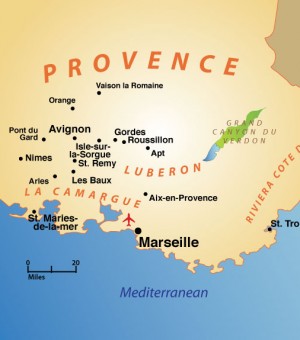Destinations > Europe > France > Provence
Basics
topWhen to Go
Spring (April, May, June) is the best time to go. Fields are awash in flowers by May. The next best season is Autumn (September, October); the weather is still warm, and the crowds are at their thinnest. Summer, (July, August) is high season. If you don’t mind crowds and rising temperatures, it is still a good time to visit. Winter months can offer some sunny days, but the Mistral wind can blow mercilessly. Still, skiing is possible from mid-November through March.
topPassport & Visa Requirements
Citizens of the US, EU and Commonwealth countries do not need a visa to enter France. However, all travelers to France must have a valid passport; and children must travel on separate passports.
topWeather and Temperature
The climate of Provence is Mediterranean. It can be quite hot in the summer, especially inland from the sea breezes. Winters are generally mild, (except for the Mistral winds), and the rainy season is in the Spring, although you might get caught in a short thunder shower in summer under the right conditions.
| JAN | FEB | MAR | APR | MAY | JUN | JUL | AUG | SEP | OCT | NOV | DEC | ||||||||||||||||||||||||||||||||||||||||||||||||||||||||||||||||||||||||||||||||||||||||
| Average High Temperature | °F | 52 | 54 | 60 | 65 | 73 | 80 | 86 | 85 | 78 | 69 | 59 | 53 | ||||||||||||||||||||||||||||||||||||||||||||||||||||||||||||||||||||||||||||||||||||||
| °C | 11 | 12 | 16 | 18 | 23 | 27 | 30 | 30 | 25 | 21 | 15 | 12 | |||||||||||||||||||||||||||||||||||||||||||||||||||||||||||||||||||||||||||||||||||||||
| Average Low Temperature | °F | 38 | 39 | 44 | 48 | 55 | 62 | 66 | 66 | 60 | 55 | 45 | 40 | ||||||||||||||||||||||||||||||||||||||||||||||||||||||||||||||||||||||||||||||||||||||
| °C | 3 | 4 | 6 | 9 | 13 | 16 | 19 | 19 | 16 | 13 | 7 | 4 | |||||||||||||||||||||||||||||||||||||||||||||||||||||||||||||||||||||||||||||||||||||||
| Average Precipitation | in | 1.39 | 0.84 | 0.86 | 1.6 | 1.05 | 0.57 | 0.32 | 0.72 | 2.24 | 2.06 | 1.54 | 1.01 | ||||||||||||||||||||||||||||||||||||||||||||||||||||||||||||||||||||||||||||||||||||||
| cm | 3.5 | 2.1 | 2.1 | 4 | 2.6 | 1.4 | 0.82 | 1.8 | 5.7 | 5.23 | 3.9 | 2.5 | |||||||||||||||||||||||||||||||||||||||||||||||||||||||||||||||||||||||||||||||||||||||
topTime Difference
Set your watch 1 hour ahead of Greenwich Mean Time (+1GMT) or 6 hours ahead of Eastern Standard Time (+6EST). France practices Daylight Saving Time, usually beginning on the last Sunday in March and ending on the last Sunday in October.
topMoney Matters
Local Currency
The local currency is the Euro (€), which is divided up into 100 cents (centimes). Notes come in denominations of €5, €10, €20, and €50, €100, €200. Coins come in €1, €2, and 50, 20, 10, 5, 2 and 1 cents.
Credit Cards
Credit cards may generally be used, though smaller shops and restaurants may not take them. Make sure to inquire before ordering. ATMs can generally be found at La Poste, even in smaller villages.
Changing Money
For best rates, change money at a bank or an American Express office. Bureaux de change storefronts are very convenient, but generally charge higher rates. Currency converter
Tipping
The French do not tip heavily. A 15% service charge and 19.6% tax are automatically added to all hotel and restaurant bills. You may tip an additional 1-5% for exceptional service.
Taxi drivers can be tipped 5-10% depending on the quality of service.
topPhones
Emergency Numbers
Emergency - 112
Medical - 15
Police - 17
Fire - 18
Cell Phones
French cell networks use the European standard GSM 900 and 1800, so your cell phone must be a Tri-Band phone to work there. If you already have a GMS phone, make sure it's activated and SIM-unlocked.
topElectrical
Electricity is 220V 50 Hz throughout France. Standard French plugs have either two parallel prongs, or two parallel prongs with third grounding blade. Most US electronics require an adaptor.
topPersonal Safety and Security
While levels of violence are extremely low, levels of casual theft can be quite high, particularly during the tourist season when pickpockets abound. When walking around crowded areas, always keep a tight grip on your wallet or purse.
topCustoms
The people of Provence are traditionally welcoming. Any efforts by English speaking visitors to make use of their French will be met with great encouragement. If you don't speak any French, try to learn some basic phrases before you go. When you enter a shop or cafe, it's customary to greet the proprietor with "Bonjour, Madame/Monsieur," and to say "Merci, au revoir" upon leaving.
Handshakes are the common form of greeting. Use standard French titles monsieur, madame, mademoiselle along with the person's last name. Les bises, or "air kisses" are only used as a greeting among people you have already met.
Copyright 2013 MyLittleSwans, LLC. All rights reserved. My Little Swans, the logo and Share a world of experience are registered Trademarks of MyLittleSwans, LLC. Use of this site constitutes acceptance of our Terms of Use and Privacy Policy.




